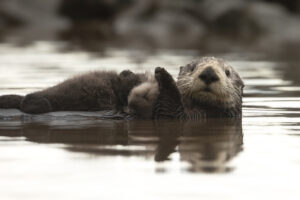At the Moss Landing Marina halfway between Santa Cruz and Monterey, I slip into a kayak and paddle toward Elkhorn Slough, one of California’s largest tidal salt marshes. Just beyond the mouth of the slough, Monterey Canyon reaches seaward for 95 miles, plunging as deep as the Grand Canyon. Upwelling of cold, nutrient-rich waters here drives the food chain that sustains the birds and mammals I hope to see.
I am not disappointed. There are birds and harbor seals all around, but the stars of the show are the southern sea otters. They float on their backs with paws out and flippers flexed to retain their body heat. (Otters don’t have an insulating layer of fat like seals.) Using their bellies as tables, they dine on clams and fat innkeeper worms, eating a quarter of their weight daily. They groom their faces and bodies to keep air bubbles trapped in their fur. (With up to a million hairs per square inch, sea otter fur is the thickest of any animal.)
The otter population at Elkhorn Slough has fluctuated through the years, but numbers are currently on the high side, according to the Pacific Cetacean Group (PCG), which has studied population trends here for over a decade. The average maximum of 52 otters in 1998 dropped to 27 in 2001 and continued falling for several years. In 2005, the population began to climb again, and in November 2006, PCG counted 98 otters and one pup. With a few exceptions, the otters here are non-territorial males, says Michelle Staedler, sea otter research coordinator at the Monterey Bay Aquarium.
The southern sea otter’s range extends from Half Moon Bay south to Gaviota, near Santa Barbara. By the 1930s, the otter was thought extinct from over-hunting, so biologists had reason to celebrate when a small population was seen near Big Sur. Those 30 or so otters seeded the current population of around 3,000. The population is now growing by three to five percent over any three-year period, but Staedler says that isn’t enough to ensure survival.
An average of 250 dead otters are found washed up on beaches every year, the victims of pollution, shark predation, starvation, toxic algae blooms, waterborne pathogens, and run-ins with fishing boats and gear. According to the Sea Otter Alliance, a group of scientists studying otter deaths, 17 percent of dead sea otters test positively for Toxoplasma gondii, a parasite found in cat waste. A bill passed in California last year requires that cat litter packages warn owners of the danger to otters when litter gets dumped in the toilet.
To learn about sea otters, go to Monterey Bay Aquarium or Sea Otter Alliance. For information about Elkhorn Slough, visit www.elkhornslough.org.

.jpg)



